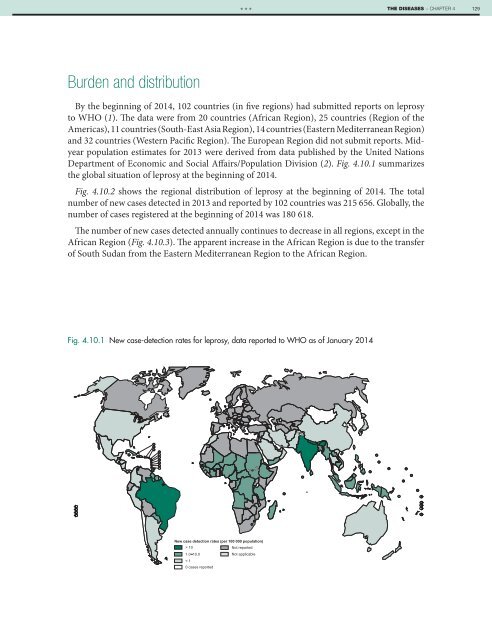1A9bnbK
1A9bnbK
1A9bnbK
You also want an ePaper? Increase the reach of your titles
YUMPU automatically turns print PDFs into web optimized ePapers that Google loves.
***<br />
THE DISEASES − CHAPTER 4<br />
129<br />
Burden and distribution<br />
By the beginning of 2014, 102 countries (in five regions) had submitted reports on leprosy<br />
to WHO (1). The data were from 20 countries (African Region), 25 countries (Region of the<br />
Americas), 11 countries (South-East Asia Region), 14 countries (Eastern Mediterranean Region)<br />
and 32 countries (Western Pacific Region). The European Region did not submit reports. Midyear<br />
population estimates for 2013 were derived from data published by the United Nations<br />
Department of Economic and Social Affairs/Population Division (2). Fig. 4.10.1 summarizes<br />
the global situation of leprosy at the beginning of 2014.<br />
Fig. 4.10.2 shows the regional distribution of leprosy at the beginning of 2014. The total<br />
number of new cases detected in 2013 and reported by 102 countries was 215 656. Globally, the<br />
number of cases registered at the beginning of 2014 was 180 618.<br />
The number of new cases detected annually continues to decrease in all regions, except in the<br />
African Region (Fig. 4.10.3). The apparent increase in the African Region is due to the transfer<br />
of South Sudan from the Eastern Mediterranean Region to the African Region.<br />
Fig. 4.10.1 New case-detection rates for leprosy, data reported to WHO as of January 2014<br />
New case detection rates (per 100 000 population)<br />
> 10<br />
Not reported<br />
1.0 10.0<br />
Not applicable<br />
< 1<br />
0 cases reported


